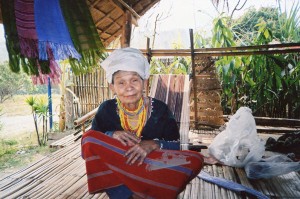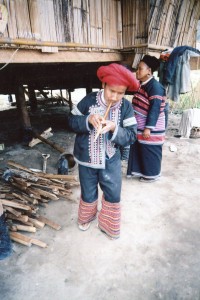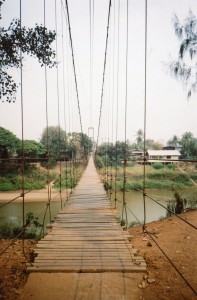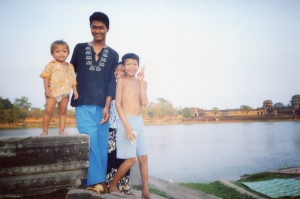It doesn’t look like much on the surface. But–
the traditional Southeast Asian home raised on stilts is one of the world’s most wide-spread cultural patterns. It helped shape people’s thinking throughout the region, and being in one is a deep experience which I still long for.
A group of Karen people in northern Thailand asked me to come into their home and play guitar for them, and they offered to cook dinner for me–Southeast Asian soul food!
Being in the home was a bit strange at first. I had to adjust to feeling the floor bend as I walked on it, and I’m a veteran of California earthquakes. But I soon enjoyed feeling nature’s rhythms with every step. The open sides of the house allowed us to see the surrounding trees and neighbors’ homes. We were immersed in nature and the community with no firm walls between anything.
Everything blended in a flow that was both gentle and vibrant. Even the floor rippled like a river.
Of course village life is far from care free. Malaria and dengue fever still plague many regions in Southeast Asia. And the houses’ openness have encouraged other perils. An old Cambodian folk tale tells husbands to avoid talking to their wives in bed at night. But the careless husband has to blabber, and a thief hiding under the house overhears where the family’s treasures are hidden, and scurries off with them.
But these traditional homes are deeply interwoven in Southeast Asian cultural patterns.
These houses encourage a different network of ideas than solid buildings on the ground, like Western homes and Chinese hutongs, do.
1. Flexibility. Before the late 20th century, Southeast Asia was sparsely populated outside the biggest cities. Labor has been the scarcest resource more often than land has (in contrast with Europe and China). A man’s power was often defined by the number of people who served him. It was relatively easy for people to move–they could disassemble or destroy their homes, and build new ones elsewhere. Southeast Asians have stressed bending with circumstances more than being tied to one piece of land.
2. Flow. Many Southeast Asian communities nestle by riversides, and most people used to rely on boats for transportation more than long routes through wild lands between villages. The basic things in people’s daily lives flow, including rivers, houses, groups of people, and the abundant foliage of the surrounding trees. Reality is more flexible than the grid of precise lines that the West has often seen as the model of order.
3. Art forms that are sinuous and flowing. Thai art is an infinitely rich world.
4. Family and community. Few Southeast Asians would want to live outside the warmth and security of the homestead. Many Thais have seen reality as a circle of safety, which includes family, the wat and rice, and they’ve sharply distinguished it from the howling wilds outside. Though Southeast Asians stress flow and flexibility, they do so within the circle of warmth.
5. Spirit cults and animism. The open walls of homes, the centrality of family and community, and the idea that flow is basic in reality encourage ideas that things in nature interpenetrate. This extends to ancestors, and to spirits in land, trees and rivers. Thais still grace their land with spirit houses.
All of these add up to a view of reality as a flow of endless variety, which is experienced with people you enjoy. No wonder why many Westerners who go there decide not to leave.
And no wonder why domestic architecture shaped Southeast Asian mosque architecture when Islam was imported.






Comments on this entry are closed.